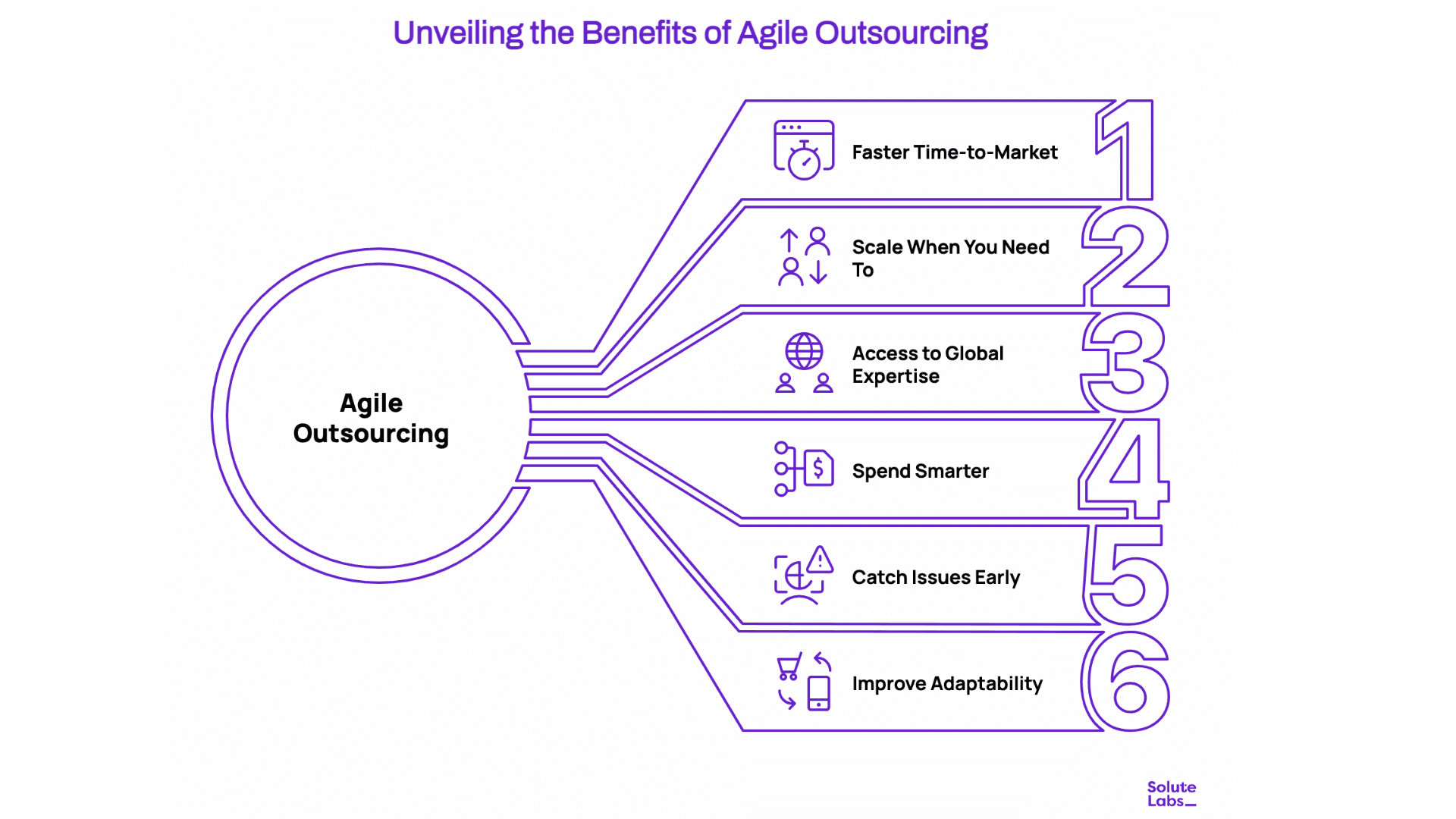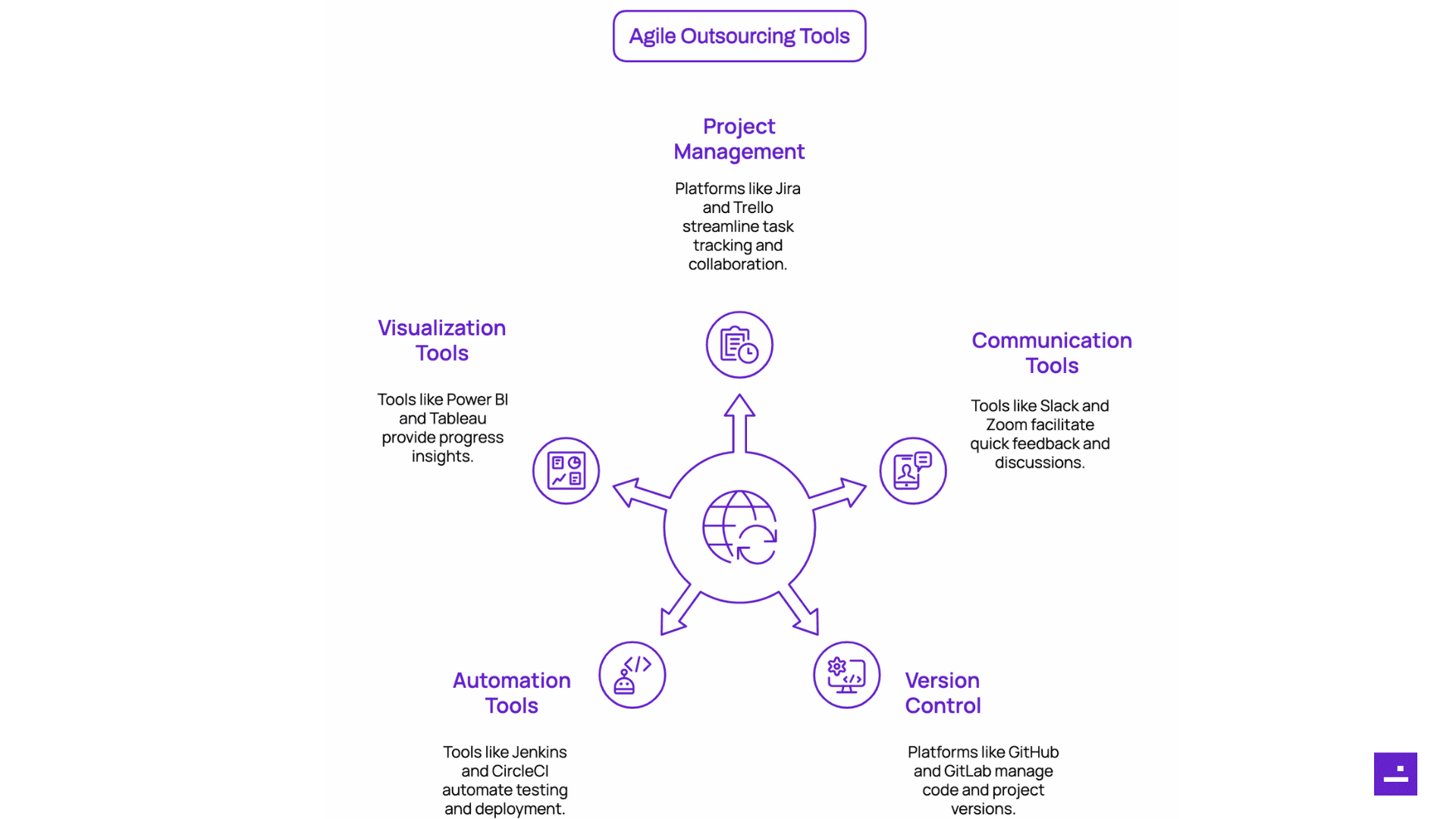If you’ve ever managed a tech project, you know the chaos. One week you’re racing toward a deadline, the next you’re reshuffling priorities because the market changed or a client had a new request. Add resource challenges on top of that, and it can feel like you’re running a marathon while juggling fire. That’s why so many companies lean on Agile to stay flexible, learn quickly, and keep projects moving.
Now layer outsourcing into the mix. Outsourcing promises access to global talent without the overhead of full-time hires. At first, Agile and outsourcing sound like opposites: one thrives on adaptability, the other is often painted as rigid. But here’s the interesting part: when combined thoughtfully, they can complement each other in powerful ways.
A recent McKinsey study even showed that companies using Agile are 1.5 times more likely to outpace their peers in revenue growth. The smart ones are no longer asking if Agile and outsourcing can work together, but how.
Why Agile and Outsourcing Seem Misaligned?
Let’s be honest, there’s a reason people think Agile and outsourcing don’t mix.
- Different Philosophies: Outsourcing is often built around fixed-scope contracts and milestone payments. Agile assumes change is inevitable, scope is fluid, and client involvement never stops.
- The “Handover Issue: Traditional outsourcing can feel like tossing your project over a wall and hoping it comes back intact. Agile flips that on its head by insisting on regular check-ins, retrospectives, and backlog refinements.
- Geography and Time Zones: It’s hard to run daily standups if your outsourced developers are 10 hours ahead and only available once a week.
- Clashing Incentives: Vendors are rewarded for hitting deadlines or shipping code, while Agile values customer satisfaction, learning, and quality.
- Rigid Contracts: Clients want locked-in budgets. Vendors want to avoid scope creep. Agile? It welcomes change.
That tension is why many companies kept Agile strictly in-house for years. It just felt safer. But the world has shifted, remote collaboration tools, changing work cultures, and the demand for speed are forcing a new conversation.
Why Agile and Outsourcing Can Actually Be Complementary?
Initially, Agile and outsourcing appear incompatible. One is characterized by perpetual change and intimate partnership, whereas the other has historically been associated with contracts, transitions, and separation. However, business seldom operates inside defined parameters. Contemporary enterprises require rapidity, cost-effectiveness, and the flexibility to adjust their scale without compromising momentum. Agile software outsourcing demonstrates that these two methods can mutually reinforce one another when executed effectively. Think about it:
1. Focus on Value Rather Than Documentation
Traditional outsourcing focused on mere task completion, finalizing the code, delivering the module, and proceeding to the next task. Agile reframes the inquiry to “Does this address the users' problem?” When outsourcing partners embrace this approach, they cease to function as mere vendors and begin to operate as genuine collaborators.
2. Expanding Without Complications
Agile outsourcing solutions eliminate the necessity of committing to a large, permanent crew. You may require additional engineers for a sprint or design expertise for a specific release. Agile provides a framework for integrating personnel as required, whereas outsourcing grants access to talent that may be unavailable locally.
3. How Agile Software Development Works in Outsourcing
The cadence of Agile, stand-ups, retrospectives, and sprint reviews ensures alignment among all participants, regardless of the geographical dispersion of engineers. Rather than waiting weeks for updates, you receive ongoing feedback and transparent insight into progress.
4. Transitioning From Vendor to Partner
Optimal Agile outsourcing partnerships are not merely transactional. They are focused on results. Rather than fixating on dates and specifications, both parties prioritize outcomes, customer adoption, market speed, and tangible corporate effect.
Outsourcing need not conflict with Agile methodologies. Indeed, its integration provides enterprises with the flexibility of Agile methodologies alongside the extensive capabilities of outsourcing. The outcome is expedited delivery, enhanced resource use, and a strategy that accommodates the erratic tempo of contemporary markets.
The Business Case for Agile Outsourcing
Let’s face it, building software today isn’t just about writing code. It’s about keeping up with shifting markets, new competitors, and customers who expect updates yesterday. That pressure is why companies are starting to pair Agile with outsourcing. On their own, each model has gaps. Put them together, and suddenly you’ve got flexibility, speed, and access to people you might never find locally.
Why does this make sense for business leaders? A few simple reasons:
1. Agility Keeps You Competitive
Markets don’t wait. Agile helps teams pivot fast, test ideas in real time, and avoid sinking months of work into something customers don’t want.
2. Outsourcing Fills the Gaps
No team has every skill in-house. Maybe you’ve got strong engineers but no data scientists. Maybe you’re missing DevOps expertise. Outsourcing plugs those holes, and Agile keeps those external experts tied closely to business goals instead of floating on the sidelines.
3. Costs Become More Predictable
Hiring full-time staff for every new project is expensive and slow. With outsourcing, you tap into skills as needed. Pair that with Agile, and the spend stays focused on outcomes, not endless hours billed.
4. Scaling Gets Easier
Big launch coming up? Spin up a larger team for a couple of sprints. Workload calming down? Scale back. Agile provides the framework, and outsourcing provides the manpower.
At the end of the day, the business case for agile outsourcing isn’t complicated. It’s about doing more with less, building faster, adapting quickly, and using global talent without carrying permanent overhead.
Key Benefits of Combining Agile and Outsourcing

Let’s face it, managing software projects today is messy. Priorities shift, deadlines move, and teams aren’t always in the same place, or even the same time zone. That’s why agile software development outsourcing makes so much sense. It’s not a magic bullet, but it solves some very real headaches.
- Faster Time-to-Market: Here’s the deal: iterative development works better when you have the right people at the right time. With agile outsourcing solutions, you can pull in specialists, integrate them into your sprints, and see results sooner. Startups especially love this because they can test ideas fast without overcommitting.
- Scale When You Need To: You don’t always need a full team. Some weeks, a couple of extra engineers can make a huge difference. Some weeks, you don’t. Agile lets you adjust workloads; outsourcing gives you the flexibility to actually make that happen.
- Access to Global Expertise: Maybe your in-house team doesn’t have cloud engineers or UI experts. Outsourcing opens up a global talent pool. The trick is to keep everyone aligned. Standups, sprint reviews, and retrospectives make sure remote experts are on the same page. That’s how agile software development works in outsourcing in real life.
- Spend Smarter: People cost money. By combining Agile with outsourcing, you only pay for what you need, when you need it. Agile ensures that money goes to work that actually matters, not to tasks nobody asked for.
- Catch Issues Early: Agile feedback loops reduce surprises. When you involve outsourced teams in reviews and retros, you catch misunderstandings or mistakes before they grow into big problems.
- Improve Adaptability: Market conditions change fast. Combining Agile with outsourcing keeps your delivery flexible. You can pivot without scrapping months of work or hiring a dozen new people overnight.
Best Practices for Making Agile + Outsourcing Work Together
Here’s the thing: just mixing Agile and outsourcing doesn’t automatically work. You can’t throw a remote team into your sprints and expect magic. It takes thought, some trial and error, and a few guiding principles to get it right.
- Set Expectations Upfront: Don’t assume outsourced teams know your processes. Explain how sprints work, what standups look like, and how retrospectives function. Even a short, casual session can save weeks of confusion. That’s one way to make agile software development outsourcing successful.
- Communicate Constantly: Time zones are tricky. Weekly emails aren’t enough. Daily or near-daily check-ins, quick ones, make a huge difference. Use video calls, chat, whatever works. Real conversation beats status reports any day.
- Focus on Outcomes, Not Hours: It’s easy to track tasks like checkboxes. Instead, ask, “Does this really create value?” Agile outsourcing solutions work best when both in-house and external teams care about results, not just activity.
- Blend Cultures and Processes: Different teams bring different habits. Don’t try to force everyone into the same mold immediately. Let teams negotiate workflow together. It might be messy at first, but collaboration improves over time.
- Use Retrospectives Properly: Even if some of your team is remote, never skip them. Retrospectives uncover friction, highlight wins, and help everyone adapt. They’re small moments that prevent big headaches later.
- Keep Things Visible: Shared boards, open backlogs, dashboards, these might sound basic, but they matter. Transparency keeps everyone accountable and reduces miscommunication.
Tools & Technologies That Enable Agile Outsourcing

Okay, so you can have the best Agile process in the world, but if your team is spread across cities, countries, or even continents, things get messy fast. You need tools. Real tools that actually make life easier instead of just looking fancy on a slide.
- Project Management Platforms: Jira, Trello, Asana, whatever you pick, it’s basically your team’s map. Everyone sees the backlog, the priorities, what’s done, what’s stuck. Without it? Chaos. For agile software outsourcing, having that shared view is almost like having everyone in the same room.
- Communication Tools:Slack, Teams, Zoom… you need these. Quick pings, random questions, short video calls, they all matter. Agile works because you get feedback fast. You can’t do that with long emails once a week.
- Version Control and Collaboration Platforms: GitHub, GitLab, Bitbucket. These are lifesavers. People can work on the same code or project without stepping on each other’s toes. It’s not just about code either; it’s collaboration in general.
- Automation and CI/CD Tools: Jenkins, CircleCI, GitHub Actions. I know, the names sound like tech jargon, but they help with testing, deploying, and catching mistakes before they go live. Super important when your team isn’t all sitting next to you.
- Visualization and Reporting Tools: Tools like Power BI or Tableau, or even built-in Agile reports. They show progress, highlight bottlenecks, and keep everyone on the same page. You’ll see where things are lagging before it becomes a disaster.
Challenges of Agile Outsourcing
Let’s be honest. Combining Agile with outsourcing sounds exciting, but it is not always easy. There are real bumps along the way. Understanding the agile outsourcing challenges can save a lot of frustration.
1. Communication Gaps
Teams in different time zones or with different language backgrounds often struggle to get on the same page. A quick question that takes two minutes in person can take hours when people are far apart. It is manageable, but you have to be proactive.
2. Shifting Priorities
Agile is all about adjusting plans and reacting to change. Sometimes, outsourced teams find it confusing when priorities change frequently. Making sure everyone understands what matters most at any given moment is crucial.
3. Cultural and Work Style Differences
Every team has its own habits. That can include coding practices, testing methods, or even the way progress is reported. The key is blending practices without frustrating anyone or slowing down the workflow.
4. Motivation and Accountability
When teams are remote, it is easy for people to feel disconnected. Regular check-ins, recognizing small wins, and open conversations can help keep the team engaged and productive.
5. Tool Challenges
Having multiple project management or collaboration tools sounds great, but if teams do not use them properly or use different ones, it just creates confusion. Choosing tools carefully and training everyone is essential.
6. Scaling the Team
For startups in particular, knowing when to add or remove outsourced resources during sprints can be tricky. That is why startups should outsource agile software development strategically. Too many people, too soon, can waste money. Too few people, and the team struggles to deliver.
The Role of Leadership in Agile Outsourcing Success
Even if your team is amazing, without leadership, stuff just falls apart. I mean, people can be talented, but if no one is actually guiding them, priorities get lost, and things slip. That’s what happens in Agile outsourcing sometimes. Leaders are not there to micromanage every little thing, but to make sure everyone knows what is happening, feels included, and actually wants to do the work. You know how it is, remote teams, different time zones, and suddenly everyone is doing their own thing.
So first, leaders have to set the vision. Not just today’s tasks, but what matters long term. The why behind it all. Otherwise, people feel like they are running in circles. And yeah, it sounds obvious, but you would be surprised how often this is missed.
Collaboration is huge. Leaders have to make it okay to ask questions, share ideas, even if it slows things down a little. Skip this, and confusion spreads like wildfire. Seriously.
Trust is another thing. You cannot micromanage. You have to set expectations and then let people do their work. Accountability happens naturally if you give them that freedom.
Mistakes? They are going to happen. And honestly, that is fine. Good leaders treat them like lessons. That is what keeps teams experimenting, learning, and improving, instead of being afraid to try new things.
At the end of the day, leadership is what holds it together. Tools, processes, talent, none of that matters if leadership is missing. Strong guidance is what makes agile software development company projects actually work. Turns chaos into clarity, effort into results. So yeah, leadership is everything.
Future Outlook: The Rise of Agile Outsourcing
So, looking ahead, Agile outsourcing is not going away. If anything, it is only going to grow. Companies are moving faster, projects are more complex, and no one has the luxury of keeping all work in-house. Startups, small teams, even big enterprises, they all realize they can tap global talent without committing to full-time hires.
The thing is, the future is less about rigid contracts and more about partnerships. Agile gives the framework, short iterations, feedback loops, and flexibility. Outsourcing brings talent and scale. Together, they let teams respond to change faster than ever.
And honestly, the technology part helps too. Better collaboration tools, communication platforms, and project tracking systems make distributed Agile work almost as smooth as being in the same room. There will always be challenges, sure: time zones, cultural differences, communication hiccups, but companies are figuring it out.
The smart ones are not just asking “Can this work?” They are asking, “How do we make it work best?” And that is why startups should outsource agile software development strategically; it allows innovation, speed, and cost efficiency all at once. I mean, it is not perfect, but it works if you do it thoughtfully.
Conclusion
Managing Agile projects with outsourced teams can get tricky, you know. That’s where SoluteLabs steps in. They offer agile teams on demand, so you can bring in the right people exactly when you need them, no long-term contracts, no extra overhead.
They don’t just add resources. The teams integrate with your processes, follow Agile routines like standups and reviews, and work like part of your own team. Startups and larger companies alike have used this approach to move faster, adapt to changes, and focus on what really matters: delivering value.
If you want to see how agile teams on demand can help your projects, contact us, and we’ll help you set up the right team for the job.






